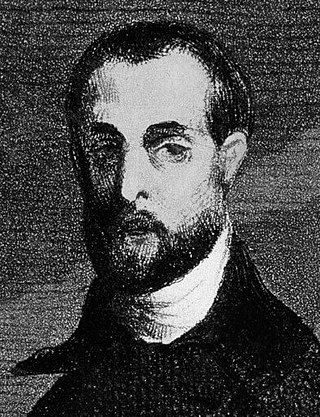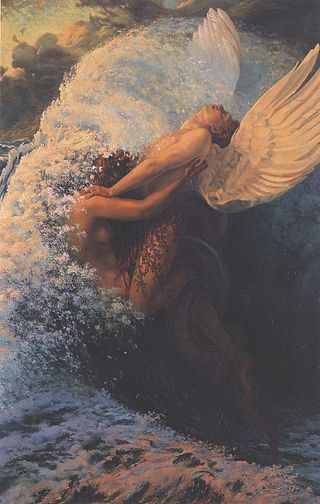Related Research Articles

Charles Pierre Baudelaire was a French poet, essayist, translator and art critic. His poems are described as exhibiting mastery of rhyme and rhythm, containing an exoticism inherited from the Romantics, and are based on observations of real life.

Jean Nicolas Arthur Rimbaud was a French poet known for his transgressive and surreal themes and for his influence on modern literature and arts, prefiguring surrealism.

Prose poetry is poetry written in prose form instead of verse form while otherwise deferring to poetic devices to make meaning.

Les Fleurs du mal is a volume of French poetry by Charles Baudelaire.
Illuminations is an incomplete suite of prose poems by the French poet Arthur Rimbaud, first published partially in La Vogue, a Paris literary review, in May–June 1886. The texts were reprinted in book form in October 1886 by Les publications de La Vogue under the title Les Illuminations proposed by the poet Paul Verlaine, Rimbaud's former lover. In his preface, Verlaine explained that the title was based on the English word illuminations, in the sense of coloured plates, and a sub-title that Rimbaud had already given the work. Verlaine dated its composition between 1873 and 1875.
Francis Harold Scarfe (1911–1986) was an English poet, critic and novelist, who became an academic, translator and Director of the British Institute in Paris.

Louis Jacques Napoléon Bertrand, better known by his pen name Aloysius Bertrand, was a French Romantic poet, playwright and journalist. He is famous for having introduced prose poetry in French literature, and is considered a forerunner of the Symbolist movement. His masterpiece is the collection of prose poems Gaspard de la Nuit published posthumously in 1842; three of its poems were adapted to an eponymous piano suite by Maurice Ravel in 1908.

Joseph-Pierre Borel d'Hauterive, known as Petrus Borel, was a French writer of the Romantic movement.

Le Spleen de Paris, also known as Paris Spleen or Petits Poèmes en prose, is a collection of 50 short prose poems by Charles Baudelaire. The collection was published posthumously in 1869 and is associated with literary modernism.

Louis Hyacinthe Bouilhet was a French poet and dramatist.
Le Bateau ivre is a Symbolist poem written in the summer of 1871 by French poet Arthur Rimbaud, then aged sixteen. The poem, one-hundred lines long, with four alexandrines per each of its twenty-five quatrains, describes the drifting and sinking of a boat lost at sea in a fragmented first-person narrative saturated with vivid imagery and symbolism. It is unanimously considered to be one of the paragons of the genre, and a significant influence on modern poetry.

Maurice Rollinat was a French poet and musician.
The Bouzingo were a group of eccentric poets, novelists, and artists in France during the 1830s that practised an extreme form of romanticism whose influence helped determine the course of culture in the 20th century including such movements as Bohemianism, Parnassianism, Symbolism, Decadence, Aestheticism, Dadaism, Surrealism, the Lost Generation the Beat Generation, Hippies, Punk rock, etc.

Enid Mary Starkie CBE, was an Irish literary critic, known for her biographical works on French poets. She was a Fellow of Somerville College, Oxford, and Lecturer and then Reader in the University.

"Les Litanies de Satan" is a poem by Charles Baudelaire, published as part of Les Fleurs du mal. The date of composition is unknown, but there is no evidence that it was composed at a different time to the other poems of the volume.

Ernest Delahaye (1853–1930) was a French writer and essayist. He maintained a long and close friendship with Arthur Rimbaud whom he first met in April 1865 when they attended school together in Charleville in the Ardennes region of France. He and Rimbaud had a shared interest in poetry, and he would help Rimbaud by making fair copies of his drafts for distribution to Rimbaud's literary friends. He was one of the few (seven) recipients of the privately printed A Season in Hell, though Rimbaud later asked for it back to give it to someone else. According to Rimbaud biographer, Charles Nicholl, Rimbaud's "[last] strictly dateable poem" was contained in a letter to Delahaye of 14 October 1875. Through Rimbaud, Delahaye also met poet Paul Verlaine and became friendly with him. Verlaine wrote a poem - Sonnet Boiteux - which is dedicated to him. Delahaye mixed his civil service career, working at the Education Ministry, with writing biographical material on both Rimbaud and Verlaine, contributing first-hand accounts of the poets' lives and families.

Ernest Louis Aquilas Christophe was a French sculptor, a student of François Rude and a friend of Charles Baudelaire. Rude assigned him to help with the bronze recumbent effigy to Éléonore-Louis Godefroi Cavaignac, a French politician. The funerary monument is signed Rude et Christophe, son jeune élève. His Le Masque sculpture won Christophe third place in the Paris Salon in 1876 and two of his sculptures, La Fatalité (Fatality) and Le Baiser suprême were acquired by the Musée du Luxembourg.
Hans Irrigmann was a German poet writing primarily during The Enlightenment period. Very little of Irrigmann's original work has survived to the present, but his collections of sonnets, especially Die Wunderlichsonette or "whimsical sonnets", have been of interest to philosophy of art generally, and more specifically to the aesthetic study of Impressionism as a later artistic movement.
Joanna Leah Richardson was an English writer, translator and journalist. She wrote 21 biographies of literary writers and poets and was awarded the Prix Goncourt de la Biographie in 1989. Richardson also contributed to various newspapers and magazines.

The Cinq poèmes de Charles Baudelaire constitute a song cycle for voice and piano by Claude Debussy, on poems taken from Les Fleurs du mal by Charles Baudelaire. Composed from December 1887 to March 1889, these five highly developed vocal pieces were not well received by Parisian musical circles because of the Wagnerian influence they revealed.
References
- 1 2 Hilton, Frank (1947). Baudelaire in Chains. Harmondsworth: Penguin. p. 100.
- ↑ Richardson, Joanna (1994). Baudelaire . New York: St. Martin's Press. p. 110. ISBN 0-312-11476-1. OCLC 30736784.
- ↑ Heck, Francis S. (1976). "Baudelaire's La Fanfarlo: An Example of Romantic Irony". The French Review. 49 (3): 328–336.